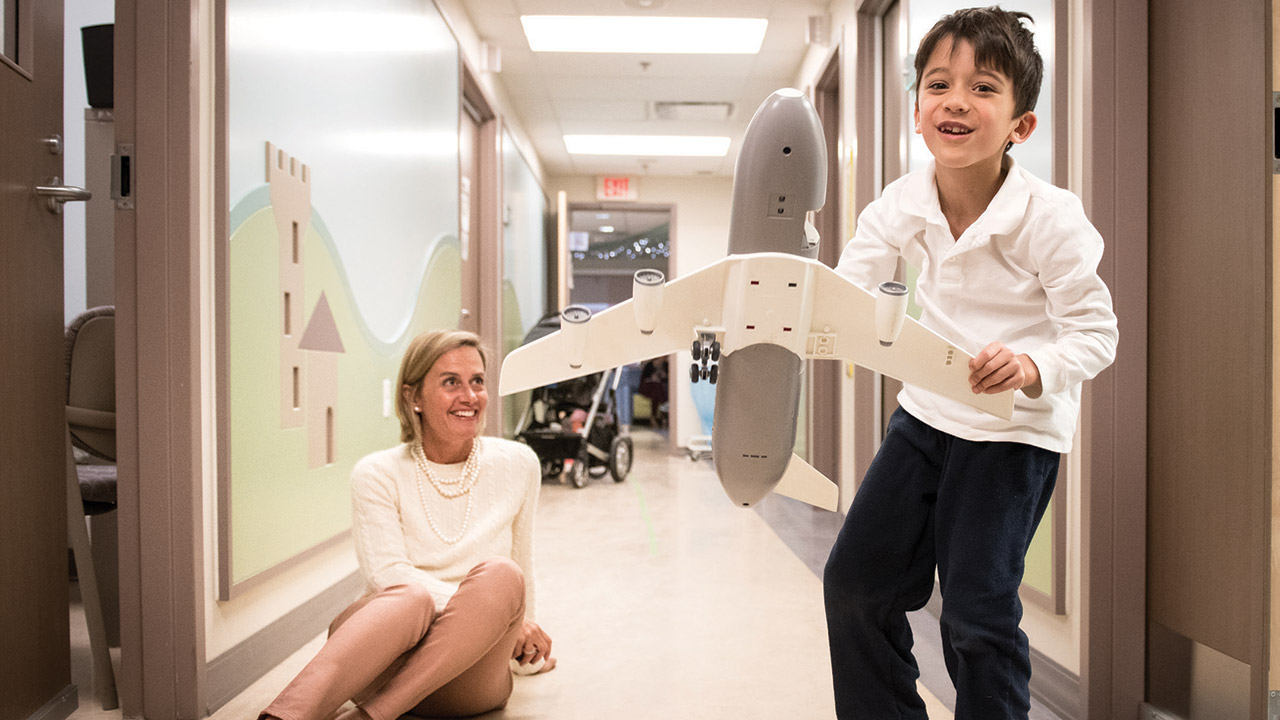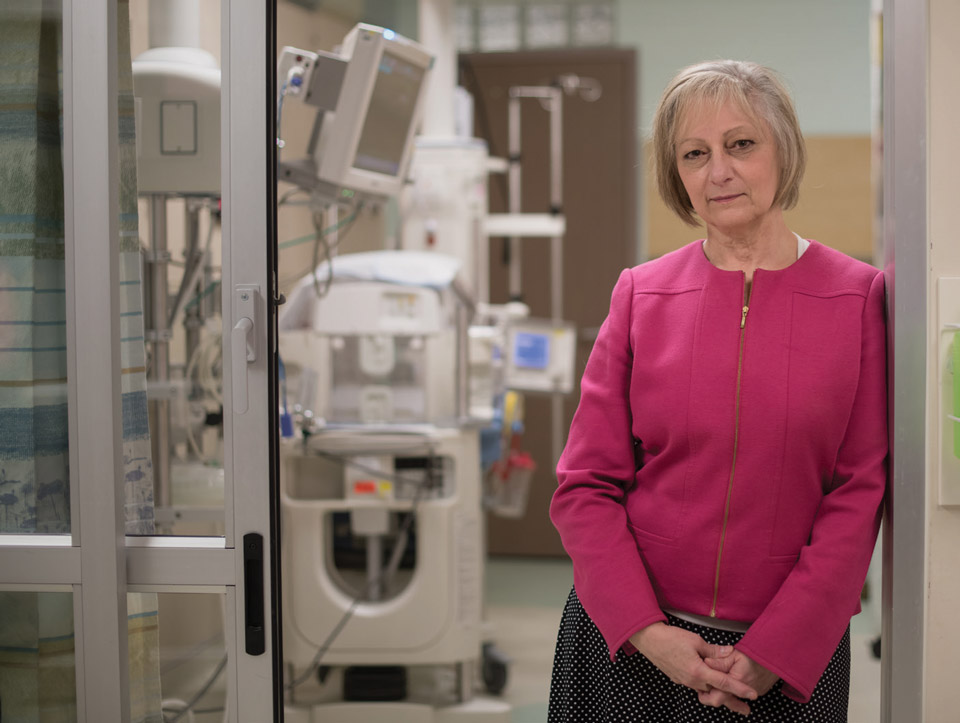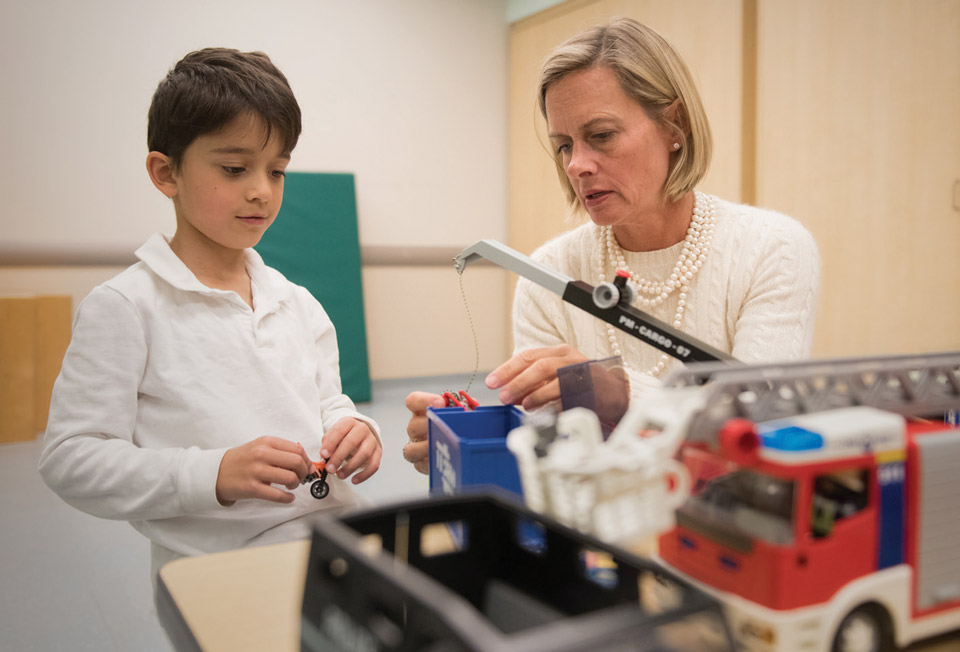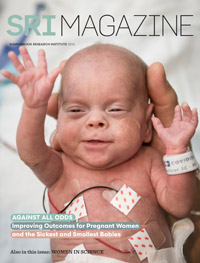Improving outcomes for the sickest and smallest babies

Chasing solutions to help preterm babies and their families survive and flourish
September 12, 2018

Dr. Paige Church, director of the Neonatal Follow-Up Clinic at Sunnybrook, and Judah Flynn, who was born two-and-a-half months early and visits the clinic periodically.
Just one generation ago it would have been unfathomable to try and resuscitate a baby born at only 23 weeks of gestation. Through medical advances, however, the limit of viability—the age at which a fetus can survive outside the womb—has shifted to include these fragile infants, many of whom now receive life-saving measures.
“I think the days of us telling parents we will or will not resuscitate are gone. When we’re at the edge of viability, I think it’s best for parents to be involved in whether or not they want their child to be resuscitated,” says Dr. Paige Church, an affiliate scientist in the Women & Babies Research Program at Sunnybrook Research Institute (SRI) and a neonatologist at Sunnybrook. She notes that of the 600 babies cared for in Sunnybrook’s neonatal intensive care unit (NICU) annually, about 220 children are born at fewer than 30 weeks of gestation. The Canadian Neonatal Network stated in its 2015 annual report that 75% of babies born at 23 weeks’ gestation received intensive care.
Being born too early is the leading cause of infant death in Canada. About 29,000 babies are born preterm (less than 37 weeks’ gestation) in the country each year. Micro preemies, the most premature babies, are born at fewer than 28 weeks of gestation and account for 2% of preterm births. In the NICU, babies born very early are hooked up to a plethora of equipment—machines to help them breathe; intravenous and other feeding tubes; and devices to monitor their heart and breathing rates, blood pressure and blood oxygen content.
Survival rates of preterm babies have improved significantly over the past few decades. American researchers have studied outcomes of extremely preterm infants over a 20-year period. They found that in 1993 the survival rate of babies born at 24 weeks of gestation was 52%. In 2012, the survival rate of these babies rose to 65%. This is a positive trend, but preterm infants—who can weigh as little as 500 grams or about three apples—are still susceptible to major illness, like bleeding in the brain and difficulty breathing. Lifelong health issues caused by prematurity may include hearing loss, neurological conditions like cerebral palsy and lung disease.

Dr. Elizabeth Asztalos is leading a clinical trial to determine if a protein in cow’s milk reduces rates of severe eye disease, breathing problems and infection in premature babies.
Church and her colleague, Dr. Elizabeth Asztalos, an associate scientist in the Women & Babies Research Program at SRI and a neonatologist at Sunnybrook, are studying whether certain interventions help preterm babies in the short and long term. Asztalos is a co-investigator of a follow-up study that evaluated the lasting benefits of caffeine citrate, a treatment that helps premature babies breathe. “Caffeine is medication that we use almost routinely in preterm babies for prevention of apnea of prematurity,” she says, noting the therapy is started on day 1 and lasts up to 10 weeks, depending on how early the baby is born. “You don’t even think twice about breathing, because there’s a whole mechanism in place. But when babies are born preterm, that’s not fully in place yet, so babies will have a tendency to kind of forget to breathe. Caffeine, the drug, will stimulate the control centre in the brain to breathe.”
| Preterm birth: A birth that occurs before 37 weeks of gestation. | 15 million: Babies born prematurely worldwide annually.* |
| Micro preemie: A baby that is born at fewer than 28 weeks of gestation. | 1 million: Deaths of kids under age five caused by prematurity each year globally.* |
| Borderline viability: Birth that occurs at fewer than 26 weeks of gestation. | 75%: Preterm babies who die that could survive if inexpensive treatments like steroid injections were available worldwide.* |
|
Survival of babies born at 24 weeks of gestation:
|
29,000: Babies who are born early in Canada each year. Preterm births have increased by 20% over the past two decades.† |
| One-third: Proportion of infant deaths in Canada caused by preterm birth.† | |
| Preterm birth is higher among Aboriginal Canadians. For example, this risk is 1.5 times higher among Inuit Canadians than the rest of Canada.† | |
*Born Too Soon: The Global Action Report on Preterm Birth. 2012.
†Canadian Premature Babies Foundation.
Asztalos co-authored the original study, which was published in 2006 in The New England Journal of Medicine. It showed that caffeine therapy decreased the rate of chronic lung disease by 10% in babies with a very low birth weight. The follow-up study then looked at 920 children from the original trial to see whether the therapy had longer-term benefits. The researchers assessed the participants, who were 11 years old, and found that while caffeine therapy did not significantly reduce the combined rate of academic, motor and behavioural impairments, it was tied to a smaller risk of motor problems. “We wanted to see whether that benefit sustained itself over time. We still see the benefit [of the therapy] from a motor perspective, but not from a cognitive one—we find that the kids all catch up with each other, whether they were in the active treatment or placebo treatment,” says Asztalos.
Preterm infants not only have trouble breathing, but they also are prone to infections due to their immature immune systems. One in particular, necrotizing enterocolitis (NEC), a bacterial infection that damages the bowel, can be fatal. “The smaller the baby, the chances of these babies surviving [it] is almost nil,” says Asztalos.
A major victory in the battle against this scourge was discovering that feeding premature babies human milk is paramount. “When we made the move to human milk with donor milk, our NEC rate plummeted substantially. At the same time, we recognized that giving [babies] their mother’s milk is equally, if not more, important, because there are properties within a mother’s milk that are important and specific to the baby, especially as it relates to developing protective mechanisms and transferring antibodies,” Asztalos says.
Some mothers of preterm infants, however, are unable to produce enough milk. Asztalos led a study to find out whether a drug called domperidone increases milk supply. Intended to stimulate the digestive system and treat stomach-related ailments, domperidone has a side effect of increasing prolactin, a hormone that triggers breast milk production. Ninety mothers whose babies were born at fewer than 30 weeks of gestation were randomized to receive either the drug or a placebo. After two weeks, the proportion of women who increased their milk supply by one-half was 20% higher in the group that received the drug. “It was validation that this is a medication that can be used in mothers, but like [with] any medication, there are many people providing caveats. It is a drug that has been unfortunately associated with sudden death or a cardiac arrhythmia called prolonged Q-Tc syndrome. The drug comes with a warning, and it’s something we have to share with mothers, so that they understand what the potential drawbacks of the medication might be,” she says. Given this concern, Asztalos says that mothers need to weigh the risks and benefits of the drug and decide whether they want to use it.
Asztalos is also helming a clinical trial that was funded by the Canadian Institutes of Health Research to study whether bovine lactoferrin, a protein in cow’s milk, reduces rates of severe eye disease, breathing problems and infection in premature babies. The study will recruit 500 infants from across Canada with a birth weight of less than three pounds. One-half of the babies will be randomly assigned to receive the supplement. After two years, the children will undergo neurodevelopmental assessments. “Our hypothesis is, if you give more of this specific lactoferrin to the babies every day, then the protective components of this compound will have a benefit in reducing a lot of the long-term morbidities in the preterm population that are often related to infection and inflammation,” says Asztalos.
The results of the study, which will take about five years to complete, could change practices in NICUs, just as the caffeine trial did more than a decade ago. “If we see a benefit, then it will mean that units can decide to start adding lactoferrin to the daily care of babies,” she says.
Home, but not home free
A child’s development after premature birth takes time and continues after discharge from the hospital. Important issues that require ongoing surveillance include possible vision or hearing loss and potential neurodevelopmental delays. “The extreme preterm child can have difficulties in school with attention, behavioural regulation and learning,” says Church, who directs the Neonatal Follow-Up Clinic at Sunnybrook. It is the only clinic of its kind in Canada that sees children up to the age of 10 years. “Historically, many clinics were cut off after [the age of ] three or four,” says Church, adding that schools are expected to pick up where clinics leave off.
She is leading research on teachers’ knowledge about the development of children who are born prematurely. She surveyed teachers in Ontario and asked them what they knew about preemies’ learning and behavioural needs. The respondents admitted to knowing little. “[Teachers] want to know more, but they don’t necessarily have avenues to do that. We also found that the parents felt that the teachers’ knowledge wasn’t that great. The teachers admitted it, and the parents said, ‘Yeah, we see it.’ But if we’re relying on people who don’t know anything about prematurity and the unique aspects of it, we sort of drop the ball,” says Church, who has submitted the study’s manuscript for publication. Addressing parental well-being is important to the health of children born preterm. Armed with evidence of this gap in knowledge, school boards can now make the case for increased funding for training and targeted interventions, she says.
Church also hopes to improve the lives of preterm infants by supporting the health of their greatest advocates: their parents. She says that parents of children who stay in the NICU for a prolonged period are under “tremendous stress.” Experts say that these parents experience multiple traumas, beginning with early delivery, followed by a steady stream of frightening news, and are at risk of post-traumatic stress disorder. Addressing parental well-being, says Church, is important to the health of children born preterm. “If a mother is really struggling with her own feelings of grief around a delivery, then it’s harder for her to fully attach to her child, and that’s the platform from which all of our development happens. We need that to be a healthy first step. It’s very important to hear from parents if they are struggling,” she says.
Church is the site investigator of a multicentre trial that is comparing the current way in which parents of kids in the NICU interact with their children’s care providers with a model that provides more help and resources while a child is in the NICU and during the transition home. It is called the Coached, Coordinated, Enhanced Neonatal Transition study.

Dr. Paige Church is studying whether coaching parents of babies in the neonatal intensive care unit using a mindfulness technique helps them to manage stress better.
Typically, the support parents in the NICU receive consists of involving them in their children’s care (for more on family-integrated care, see sidebar). Research on family-integrated care shows that it decreases parents’ stress and improves infant growth. Here, parents are not considered visitors to the NICU but rather an active part of the care team. Under the new model, which complements family-integrated care, a support worker coaches parents using a mindfulness technique called acceptance and commitment therapy. The intervention teaches people to accept what is out of their control, and to commit to action that enhances their lives. The researchers will assess if this approach helps parents to manage stress better than simply allowing them to do some of their baby’s care. “The problem is, if you ask a parent in the NICU if they’re anxious, they’ll say, ‘Yes.’ If you tell them they shouldn’t be, they’ll say, ‘You’re crazy, because my baby is sick,’” Church says. “That’s not a great therapy in the NICU because their worry and anxiety are appropriate. Instead of telling them that it’s wrong to be anxious, we’re telling them, ‘How do you let your anxiety live with you, without it taking over your life and changing who you are?’”
She urges parents in the NICU to prioritize their mental health. “I think that’s huge. You are the ones advocating for your child and pushing for the schools to learn about prematurity. Parents often are the ones that move mountains.”
Fine-tuning care for delicate newborns
Little changes can add up to big improvements for Sunnybrook’s smallest and sickest patients, says Dr. Eugene Ng, an associate scientist in the Women & Babies Research Program at Sunnybrook Research Institute. Ng is also the head of neonatology and medical director of the neonatal intensive care unit (NICU) at Sunnybrook. For these babies, who in some cases are born as early as 23 weeks of gestation, making sure that their head position is neutral and not off to one side, or clamping the umbilical cord just a little after birth—around 60 seconds later—can reduce the chances of bleeding in the brain, a devastating brain injury to which micropremature infants are particularly susceptible. Micro preemies are babies who are born younger than 28 weeks or weigh less than 800 grams. Sunnybrook cares for 70 to 80 of these incredibly tiny babies annually. “We have created a niche in focusing on this group,” he says.
Researchers in Sunnybrook’s NICU are studying whether measures like these are better for very vulnerable babies. “If we can protect the brain even from when the mom presents with preterm labour, to how we transition from birth and how we care for them in that critical time in the first week or two, then we might produce better outcomes,” says Ng, who refers to these changes as practice “bundles.” “For example, in the brain care ‘bundle,’ we included a few things that we think will optimize brain protection and put them all in place at once, and look for improvement in rates of brain hemorrhage,” he says.
Ng has also studied whether parents being more involved in caring for their children in the NICU is beneficial. He was the site investigator of a large, multicentre clinical trial that was the first to evaluate the effectiveness of family-integrated care in this setting. More than 200 families were recruited at Sunnybrook. Parents in the intervention arm spent at least six hours a day, seven days a week at their baby’s bedside, and provided care by feeding, dressing and bathing their child. They were also encouraged to participate in ward rounds and document their child’s growth and progress. Babies who received family-integrated care gained more weight than did those in the standard care group. Parents in the family-integrated care group had lower average stress scores than parents in the control group. Ng says that he considers parental well-being the most important metric in the study, and that family-integrated care, which is now standard practice at Sunnybrook, is gaining traction in NICUs worldwide. “Ultimately, what we want is a less-stressed parent because they feel like they’re in control in the unit, but also to get them ready to be the best advocate for their babies. That, in essence, is what family-integrated care is all about.”
Asztalos’ and Church’s research studies are funded by the Canadian Institutes of Health Research.



